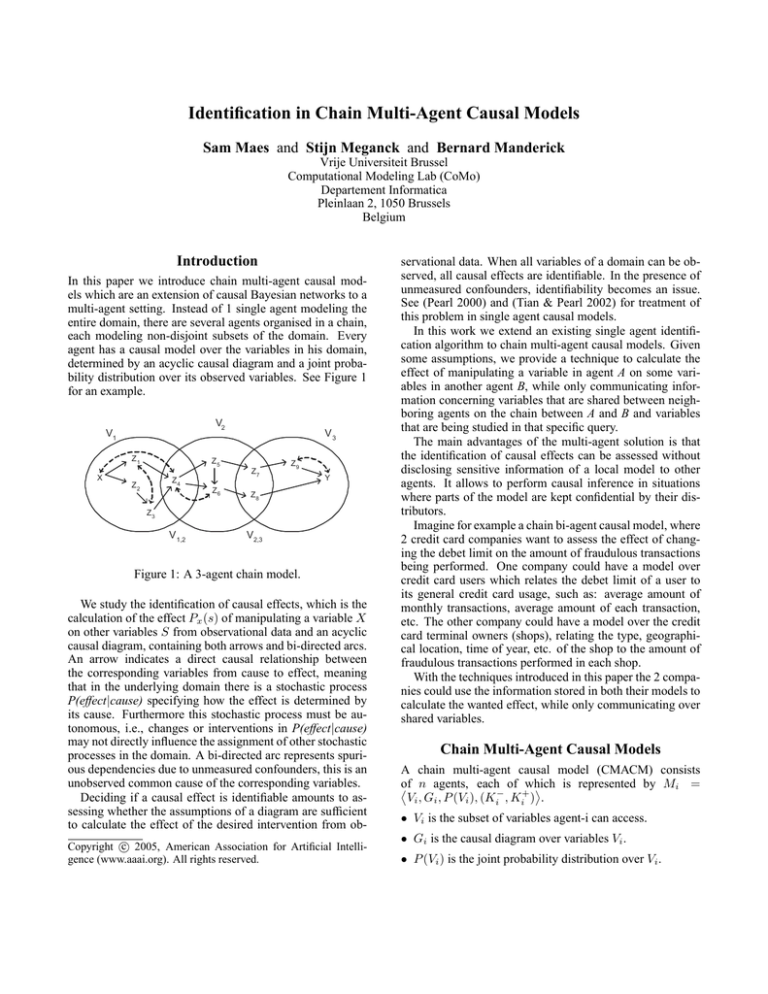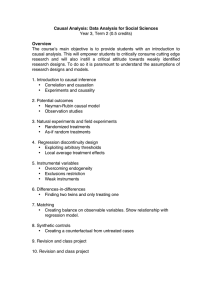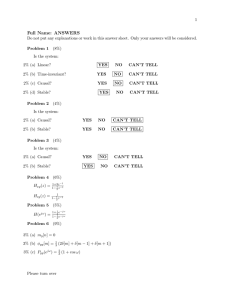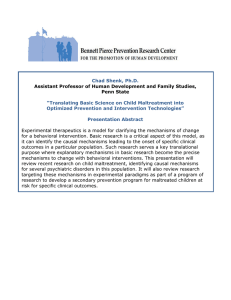
Identification in Chain Multi-Agent Causal Models
Sam Maes and Stijn Meganck and Bernard Manderick
Vrije Universiteit Brussel
Computational Modeling Lab (CoMo)
Departement Informatica
Pleinlaan 2, 1050 Brussels
Belgium
Introduction
In this paper we introduce chain multi-agent causal models which are an extension of causal Bayesian networks to a
multi-agent setting. Instead of 1 single agent modeling the
entire domain, there are several agents organised in a chain,
each modeling non-disjoint subsets of the domain. Every
agent has a causal model over the variables in his domain,
determined by an acyclic causal diagram and a joint probability distribution over its observed variables. See Figure 1
for an example.
V2
V1
Z1
X
V3
Z5
Z7
Z4
Z2
Z6
Z9
Y
Z8
Z3
V 1,2
V2,3
Figure 1: A 3-agent chain model.
We study the identification of causal effects, which is the
calculation of the effect Px (s) of manipulating a variable X
on other variables S from observational data and an acyclic
causal diagram, containing both arrows and bi-directed arcs.
An arrow indicates a direct causal relationship between
the corresponding variables from cause to effect, meaning
that in the underlying domain there is a stochastic process
P(effect|cause) specifying how the effect is determined by
its cause. Furthermore this stochastic process must be autonomous, i.e., changes or interventions in P(effect|cause)
may not directly influence the assignment of other stochastic
processes in the domain. A bi-directed arc represents spurious dependencies due to unmeasured confounders, this is an
unobserved common cause of the corresponding variables.
Deciding if a causal effect is identifiable amounts to assessing whether the assumptions of a diagram are sufficient
to calculate the effect of the desired intervention from obc 2005, American Association for Artificial IntelliCopyright gence (www.aaai.org). All rights reserved.
servational data. When all variables of a domain can be observed, all causal effects are identifiable. In the presence of
unmeasured confounders, identifiability becomes an issue.
See (Pearl 2000) and (Tian & Pearl 2002) for treatment of
this problem in single agent causal models.
In this work we extend an existing single agent identification algorithm to chain multi-agent causal models. Given
some assumptions, we provide a technique to calculate the
effect of manipulating a variable in agent A on some variables in another agent B, while only communicating information concerning variables that are shared between neighboring agents on the chain between A and B and variables
that are being studied in that specific query.
The main advantages of the multi-agent solution is that
the identification of causal effects can be assessed without
disclosing sensitive information of a local model to other
agents. It allows to perform causal inference in situations
where parts of the model are kept confidential by their distributors.
Imagine for example a chain bi-agent causal model, where
2 credit card companies want to assess the effect of changing the debet limit on the amount of fraudulous transactions
being performed. One company could have a model over
credit card users which relates the debet limit of a user to
its general credit card usage, such as: average amount of
monthly transactions, average amount of each transaction,
etc. The other company could have a model over the credit
card terminal owners (shops), relating the type, geographical location, time of year, etc. of the shop to the amount of
fraudulous transactions performed in each shop.
With the techniques introduced in this paper the 2 companies could use the information stored in both their models to
calculate the wanted effect, while only communicating over
shared variables.
Chain Multi-Agent Causal Models
A chain multi-agent causal model (CMACM) consists
is represented by Mi =
of n agents, each− of +which
Vi , Gi , P (Vi ), (Ki , Ki ) .
• Vi is the subset of variables agent-i can access.
• Gi is the causal diagram over variables Vi .
• P (Vi ) is the joint probability distribution over Vi .
• (Ki− , Ki+ ) stores the intersections with neighboring
agents on the chain Vi−1,i = {Vi ∩ Vi−1 } and Vi,i+1 =
{Vi ∩Vi+1 } respectively. We assume that the agents agree
on the structure and the distribution of their intersections.
In the CMACM of Figure 1:
V1 = {X, Z1 , Z2 , Z3 , Z4 }, V1,2 = {Z4 }
V2 = {Z4 , Z5 , Z6 , Z7 , Z8 }, V2,3 = {Z7 , Z8 }
V3 = {Z7 , Z8 , Z9 , Y }
Px (s) =
Chain Multi-agent Identification
First we introduce the notation PxV (d), meaning that Px (d)
is calculated in the model with variables V . When the superscript is dropped, this implies that the entire set of variables
is being used. We start with the following lemma:
Lemma 0.1 (Domain Reduction)
Consider a causal model with variables V , consisting of
disjoint subsets A, B, and D, and V = (A ∪ B ∪ D). Let
X ∈ A and Px (d) be identifiable using a single agent identification algorithm, with Ch(X)∪P a(Ch(X)) ⊂ (A∪D).
Then, the following holds:
(1)
This lemma implies that if no bi-directed edge is connected to any child of X, Px (d) can be calculated equivalently in the entire domain V and in V \B, where B is a set
of variables which contains no children of X and parents of
children of X.
Next, we introduce a lemma that combines Lemma 0.1
and bi-agent identification from (Maes, Meganck, & Manderick 2004).
Lemma 0.2 (Recursive Chain Identification)
Consider a setting where D is a D-separation set between
X, X-rest and Y, Y-rest. If the assumptions of bi-agent identification also hold with V1 = (X, X-rest), V1,2 = D and
V2 = (Y, Y -rest), then
!
X
X
Px (y) =
P (y, y-rest|d)
(2)
PxX,X-rest,D (d).
D
X
V2,3
In (Maes, Meganck, & Manderick 2004; 2005) we extended a single agent algorithm to the bi-agent case, i.e., a
setting where there are 2 agents each modeling a part of the
domain. There is 1 agent with the model that contains the
manipulated variable X and the other with the model containing the variable(s) S to be studied. Some of the assumptions for the algorithm to calculate Px (s) are:
1. there is no bi-directed edge connected to any child of X.
2. V2 ⊥⊥ V1 |V1,2 , i.e., V2 is conditionally independent of V1
given the intersection.
3. P a(Ch(X)) ⊂ (V1 ∪ V1,2 ).
PxV (d) = PxV \B (d) = PxA,D (d)
Theorem 0.3 (Multi-Agent Chain Identification)
Consider a setting as in Figure 1, where V2,3 is a Dseparation set between V3 and the remaining variables.
Then:
Y -rest
This lemma implies that if D is a separation set, the calculation of Px (y) can be separated in 2 parts: first calculating
the effect of X on D in the model (X, X-rest, D), then
multiplying this with the sum over Y -rest of P (y, y-rest|d).
V ,V
PxV1 ,V1,2 ,V2 ,V2,3 (v2,3 ).
X
V3 \S
P (v3 |v2,3 )
(3)
,V ,V
Px 1 1,2 2 2,3 (v2,3 ) will be calculated by applying biagent identification, where the calculations over (V1 , V1,2 )
and (V1,2 , V2 , V2,3 ) are performed separately. After the
part over (V1 , V1,2 ) is marginalized to a distribution over
(X, V1,2 ), it is communicated to agent2, where the rest of
the calculation is performed.
This theorem implies that multi-agent identification can
be performed over a chain of 3 agents, starting with a calculation between the first two agents, resulting in a distribution
over X, the variable that is being intervened on, and V2,3 ,
the intersection between agent2 and agent3. Separately, in
agent3 a local calculation is performed which results in a
distribution over V2,3 , i.e. the intersection with agent2, and
S, the set of variables that we are studying. This result can
easily be extended to chains with > 3 agents, by iteratively
applying the theorem. The proofs of these lemmas and theorem are out of scope for this paper.
Conclusion
In this paper we introduced the paradigm of chain multiagent causal models (CMACMs), which are an extension
of causal Bayesian networks to a multi-agent setting, where
the agents are organised in a chain, so that an agent has a
maximum of 2 neighbors. x Given some assumptions, we
provided an exact technique to calculate the effect of manipulating a variable in agent A on some variables in another
agent B, while only communicating information concerning
variables that are being shared between neighboring agents
on the path between agents A and B and variables that are
being studied in that specific query (i.e. X and Y in Px (y)).
References
Maes, S.; Meganck, S.; and Manderick, B. 2004. Multiagent identification of causal effects. In Ghidini, C.;
Giorgini, P.; and van der Hoek, W., eds., Proceedings of
the 2004 European Workshop on Multi-Agent Systems (EUMAS), 409–417.
Maes, S.; Meganck, S.; and Manderick, B. 2005. Causal
inference in multi-agent causal models. In Proceedings
of Modèles Graphiques Probabilistes pour la Modélisation
des Connaissances, Atelier of EGC 05, 53–62.
Pearl, J. 2000. Causality: Models, Reasoning and Inference. MIT Press.
Tian, J., and Pearl, J. 2002. On the identification of causal
effects. Technical Report (R-290-L), UCLA C.S. Lab.





